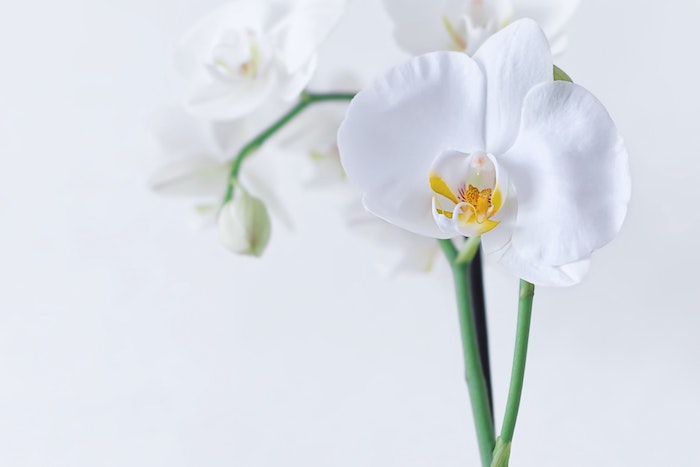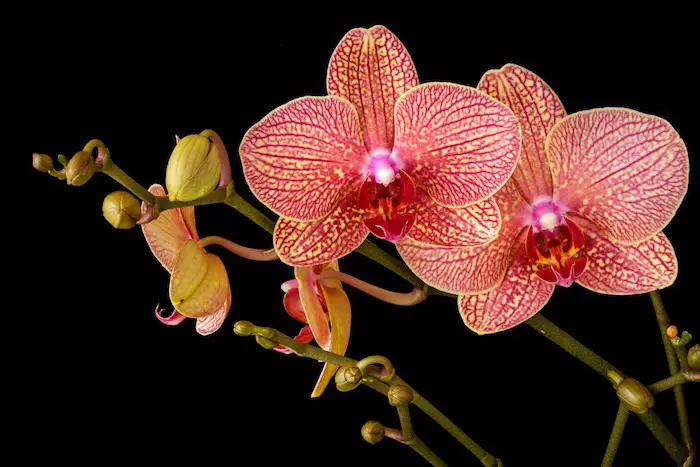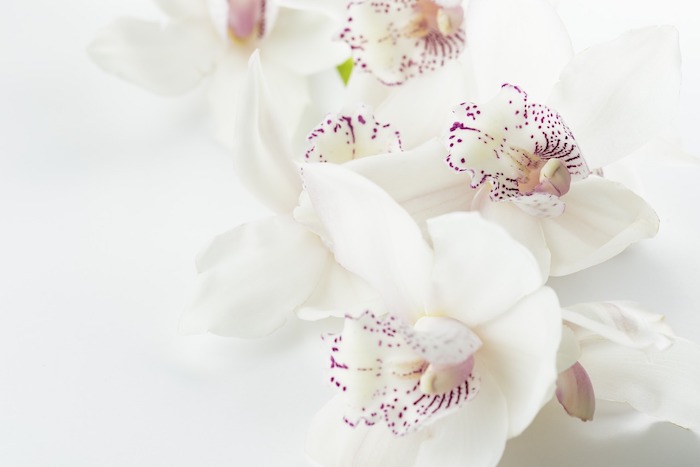It is said that the varied and stunning orchids make up the world’s largest family of plants, with the different species being cultivated for houseplants. There are none equal in comparison to the fragility, form, or grace of these flowers.
The blooms maintain for a lengthy duration. No one ever knows what to do with the plant once they are spent. The most common variety of orchid is the Phalaenopsis as the easiest to grow, comprising a vigorous stalk with many flowers.
It can bloom as long as two months provided it receives proper care. Ultimately, though, there will come a time when the lovely flowers will begin to fall off, and the first question that comes to mind, particularly for a novice, is, ‘why are my orchid flowers falling off?’
The process is very natural for older orchids once the blooming process is finished. If it appears to be happening prematurely, there is the possibility of ‘bud blast’ due to changes in the atmosphere, such as light, temperature, or humidity.
Sudden drastic changes of this nature can result in shock, making buds and flowers drop. You’ll know if the process is naturally happening because the process will begin close to the crown near the top of the spike, and typically they will drop one at a time.
The flowers won’t fall off all at the same time, or if the buds are dropping before they even have the chance to bloom, there is no doubt the plant is in shock due to ‘bud blast.’
What Are Some Unusual Causes Of Bloom Loss?
Many gardeners new to orchids mistakenly believe that their plant is dead when the blooms stop, and the orchid goes into dormancy. Most don’t realize this is only the case with orchids being dormant until time to rebloom, not other houseplants.
The process is all part of a healthy life cycle for the plant. With the proper care and adequate effort to manipulate the new blooms, the plant will again display the gorgeous array of flowers similar to its original glory.
Sometimes blooms are lost due to unusual circumstances. These could be due to improper care techniques or illness of the plant itself. Proper education can help identify normal loss through the orchid’s lifespan and potential trouble for a plant needing help.
Average loss occurs after 2-3 months of flowering without any issues with the flowers merely wilting and petals beginning to fall, followed by the plant resting. If the loss is something resulting from improper care or plant health, you will need to intervene.
- Lacking Water: You will know your orchid is not receiving enough water by checking the roots. If you notice that they are gray in color or brittle and dry, this can mean the plant is thirsty, causing premature loss.
The health of the orchid can be salvageable depending on the level of deprivation by starting the suggested watering regimen from the source which gave you the plant. If it still struggles, soak the roots/bark for a few minutes in a bucket, drain.
- Soppy: If you have been providing too much water, it can be just as damaging as too little with the potential of root rot. Prevention is simple by watering with ice once per week, which is a proven successful technique.
Before you add more water, you will need to let the roots dry out from the overwatering first.
- Sudden Environment Changes: When there is sudden exposure to a cooler environment or a draft, it can lead to ‘bud blast.’ This will cause buds to drop prematurely. It should stay in a continually warm spot between 65-80 Fahrenheit (ca. 27 °C).
- Fruit Is Not An Orchid’s Best Friend: Once fruit becomes ripe, it can cause ‘bud blast’ through its emission of ethylene gas. The simple solution is to move the plant away from the area.
The recommendation is to keep the pot in an area other than the kitchen. That way, there is no chance of any exposure.
Through the proper research, you will have the education to know when the plant is losing its flowers because it’s experiencing a typical life cycle or going through a period of distress for which quick action can potentially save it.
What Is Considered The Proper Care For An Orchid?
In a normal flowering process of an orchid, after blooming is complete, they will naturally wilt and drop before the plant rests. Resting or dormancy is natural for the Phalaenopsis life in order to store energy so that it has the capacity to rebloom.
You must continue to care for a dormant plant if you want to be rewarded with more bright, healthy, beautiful flowers. The way to care for it in the best possible way to encourage this process includes:
- Watering: Even though there are no flowers or blooms doesn’t mean that you can stop watering. The orchid will continue to need the recommended three ice cubes on the same day every week – only one cube for a mini plant. Place 2-3 ice cubes on the orchid potting medium. Try to keep the ice away from the roots, crown and leaves in order to prevent damage to those portions of the plant
Neglecting the watering component has the potential to cause stress to the plant, which will affect any chances of the plant reblooming. It’s important to remember to keep to the watering routine consistently.
- Fertilization: Orchids are unique from the common houseplant in a multitude of ways, one of which is how they intake their nutrients, which is through fertilizer and a potting supply as opposed to feeding on the soil.
The nutrients that they receive are particularly crucial during dormancy with the recommendation to fertilize biweekly or one time each month using a balanced fertilizer. Water should not be given in the same week that the fertilizer is given.(没找到)
- Lighting: There should be sufficient indirect light surrounding the orchid even when it is at rest. The suggestion is to place it behind a sheer in a window facing either north or east, so it’s protected from the direct sun.
Some regions or even some homes have little exposure to natural sunlight. In these cases, it’s recommended to get a growth light and place it with the orchid.
- Change Temperature: These are plants that love the warmth with temps that range above 65 and below 80 Fahrenheit (ca. 27 °C) throughout the daytime. At night, though, an orchid should be placed in a cooler room for a few weeks.
This is done while the plant is dormant to help trigger new blooms. The temperature should be between 65 to 75 degrees Fahrenheit (ca. 24 °C).
- Enhance The Plant: While at rest, it may be challenging to keep the plant looking attractive. The stem has the potential to become brown and dry with the leaves turning limp and flat with a dull, faded look.
The recommendation is to disguise the dormancy with a silk stem of a similar variation using care not to disrupt the roots, or put the pot in a much larger one of complementary greenery.
Please understand that just because your orchid has lost its flowers doesn’t mean it’s now compost. This plant still has a lot of life and needs just as much care to bring back its signature style and beauty.
What Should You Do After ‘Bud Blast?’
Usually, an orchid will flower for approximately three months in its life cycle, at which point the buds will start to wilt and drop off each one at a time. The flowers shouldn’t fall off at the same time or fall off prematurely unless there are unusual conditions
One such instance is ‘bud blast’ for which all people who care for these beauties will experience at least once. Buds and flowers are susceptible, particularly to changes in the environment. Bud blast can happen even in bringing a newly purchased plant home.
If the dried up blooms haven’t dropped, it’s okay to manually remove them from the spike but leave the spike intact. There is the potential for new flowers to produce from the tip. You also have the option of trimming the spike back.
Take it an inch above the closest node where the first flower came. The suggestion is that this will encourage a second spike, which will be reminiscent of a ‘branch’ on the spike producing more blooms.
Another choice is to remove the spike entirely, cutting it tightly to the base. Even though there are more flowers possible from it, they likely will be smaller and less appealing than the original batch.
Critical in the process is investigating the cause for the ‘bud blast’ so it doesn’t reoccur. There may be something that you habitually do to harm the orchid that may keep the plant from blooming altogether.
When Should Orchids Bloom?

Phalaenopsis note to be the most common variety of orchids. The claim is that this version should flower every year with some instances of blooming a few times in a year, and then there are times when they won’t grow a spike. Reasons for this can include:
- Light is insufficient
- Issues with roots
- Temperature problems
- Stress for the plant
- Pest infestations
With orchids, one of the first indicators of an issue will be the roots. The condition will give you an indication of the plant’s health. If you’re not receiving blooms, the suggestion is to repot and inspect the roots trimming any that are poor.
Fresh potting mix has the potential to make an orchid happy with the new supply of nutrients. After repotting, the recommendation is to place it under a grow light specific for an indoor plant. It’s sometimes difficult to have access to natural sunlight.
Also, tough for some people is climate control. If there isn’t an appropriate drop in the nighttime temperature, spiking can’t be induced. A stable temperature is not a pleasant atmosphere for an orchid, and they won’t bloom in those conditions.
All of these conditions bring stress to an orchid. When the plant is under any kind of distress, it won’t produce spikes in its next season. You need to ensure that all the needs are met, such as keeping harmful pests from doing damage and watering correctly.
What Are Some Orchid Issues To Watch Out For?
The longer you have your orchid, the more likely you will experience illness or pests. Or you could potentially unknowingly purchase a plant that already has an ailment of which you weren’t aware.
When it comes time to treat the illness, you want to employ only the cleanest pots and tools. After taking care of your orchid, clean the tools, and wash your hands thoroughly. Some of the more common issue seen with orchids:
- Spotted flowers: Flowers showing spots, also known as botrytis is something usually seen with light-colored varieties. This happens in places with poor airflow, continually humid, wet conditions in a cool/cold weather situation.
The solution for treatment is to remove the affected areas to keep it from spreading and take it out of the current conditions.
- Water On The Crown: When water remains on the crown of the foliage when the conditions are cool, it results in ‘crown rot,’ most commonly in Phalaenopsis, but it is possible with any variety with leaves capable of forming a crown.
You need to take out the entire amount of affected tissue using clean cutting blades and then use cinnamon sprinkled on the surface to help with the wounds. It can be salvaged if caught quickly, but often it’s too late once it’s found.
Also make sure there is good airflow in the space where the plant is located and try to water early morning, so there is no moisture when the temperatures drop in the nighttime.
- Dealing With Insects: The claim is that orchids are only susceptible to a few pests, but anyone who has grown these have been subjected to bugs. Thinking that you will never have that issue is merely a novice perception.
The first thing that should be done if there is an indication that the plant is infested is to isolate it from any others. Bugs will spread quickly in the amount of time that it takes to notice that they’re present.
Use every safety precaution when instituting insecticide and make sure to finish a complete cycle of the treatment. Every pest offers a unique stage in its life cycle, each being affected differently by the products.
The potential of using home remedies or natural, organic products are a safer alternative to insecticides, which introduce toxic chemicals into the environment.
Some of the most common insects orchids fact include:
1: Mealy Bug – seen on the bottom of the leaves as a white ‘cotton-like’ mass. They can also be found on the actual flowers on the base of the buds. They have the potential for causing deformities in the foliage and blooms.
2: Scales – Brown or scale are the most commonly seen and are difficult to eliminate. Ants can be the host introducing these pests into the environment.
3: Aphids – These comprise soft bodies and tend to gather in clusters around developing buds, spikes, or leaves. They produce a ‘honeydew-like’ solution that attracts ants and can be a growth platform for ‘sooty mold.’
4: Thrips – Thrips aren’t as common but are the scariest for the plant as they are virtually invisible until the flowers open, and they have been chewed along the edges, and they can be seen against the light-colored bloom.
You can be as diligent and careful of a gardener as a professional caliber and still experience pests. It’s not something anyone can avoid. They do come, and you will need to educate on dealing with them. How you choose to do so is a personal preference.
Many people choose to forego chemically-laden insecticides in favor of natural, organic options inclusive of home remedies. In some instances, basic rubbing alcohol or plain dish soap and water will suffice as a solution, particularly for aphids.
Final Word
Orchids are among the world’s most identifiable exotic blooms with their delicate, graceful beauty. The estimation is that there are nearly 20,000 different species with a vast array of colors, shapes, and sizes.
This makes them an excellent decorative touch for any household aesthetic. The problem is that many homeowners are hesitant to incorporate them with the fear that they are too high maintenance and fragile to care for.
It’s possible to have orchids for many years, depending on the level of care you give them and their development of a consistent ‘natural’ lifecycle. When you get involved with plants of any nature, you need to want to be responsible for them and commit to their care.
But the misconception that orchids are too much of a challenge is a myth that has followed them consistently. The fact is they can be pretty easy to take care of. They’re just unique from other types of houseplants, which causes the intimidation.
You’re only as limited in your ability as you believe. Research, speaking with other people who have these plants, and following the guidelines makes the perfect recipe for success so you can have glorious blooms year after year.
See Also:
7 Ways On How To Keep Orchids Alive
Are Orchids Fragrant? (Here’s The Answer)
Why Are My Orchids Flowers Falling Off
Ultimate List Of Fragrant Orchids


